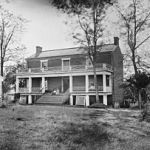Appomattox: A Hardfought Surrender
Had it not followed years of death and destruction, Lee’s surrender to Grant would be remembered as a comedy of errors.
Everyone knows about the Surrender at Appomattox: April 9, 1865. Wilmer McLean’s parlor. Robert E. Lee on time, in an immaculate uniform. Ulysses S. Grant late, in a mud-spattered private’s blouse. Lee not remembering Grant from the Mexican War. Grant not knowing Confederate soldiers owned their mounts. Grant writing out terms. Lee signing them. Lee riding to tell his army. Grant wiring to tell Lincoln.
What not everyone knows is that the entire surrender process had been a fight against a series of vexing circumstances.
The remnants of the once noble and seemingly invincible Army of Northern Virginia went into battle for the last time on the foggy morning of April 9, 1865. Surrounded by Federal forces, rebels under General John Gordon sought to break through the Union cavalry line west of Appomattox Court House then flee south to continue fighting with Confederate forces in North Carolina.
Gordon’s seasoned soldiers did penetrate the Union cavalry line, but Gordon reported they had been fought “to a frazzle.” To make matters worse, when the fog lifted, thousands of Federal infantrymen who had arrived during the night could be seen. Hearing that news, Lee saw surrendering as his only reasonable option and thought he knew exactly when and where it would happen.
*****
In a note sent to Lee on April 7, Grant declared the situation of the Army of Northern Virginia “hopeless” and that its surrender would avoid “any further effusion of blood.” In his reply, Lee disagreed with the evaluation of hopelessness but asked Grant to delineate the terms he would propose for surrender. The following day, April 8, Grant set forth standard terms of surrender: “Men and officers shall be disqualified from taking up arms against the government of the United States until properly exchanged.” In addition, he offered to meet Lee at a place of the latter’s convenience. Lee proposed meeting at “10 a.m. on the 9th on the old stage road to Richmond between the picket lines,” but emphasized that he intended only to discuss Grant’s proposal in general. He added that he was “looking forward to a restoration of peace.”
Lee, of course, would have cheerfully stood up Grant had Gordon’s breakthrough been successful, but midmorning found him waiting for Grant at the appointed spot east of Appomattox Court House, albeit for a different purpose. Wanting to prevent more casualties, he set about arranging a short truce with Union forces both in the quiet Confederate rear and at the rebel front, where Gordon’s troops were engaging with Federal infantry.
Lee sent a courier to Gordon, instructing him to inform his Union counterpart of the temporary cessation of hostilities. Gordon instructed one of his staff officers, Colonel Green Peyton, to deliver the message under the traditional symbol of truce, a white flag. But there was a snag: No flag of truce was available. Gordon told Peyton to tie his handkerchief onto a stick. Peyton did not have a handkerchief, and– apparently– neither did Gordon, who instructed Peyton to tear off a piece of his shirt. Peyton pointed out that he, like Gordon and every other man on hand, was wearing flannel. In his Reminiscenses of the Civil War, Gordon says he then ordered Peyton to “Get something and go!” An obedient subordinate, Peyton soon approached the Union line under a dingy rag of truce.
The firing west of Appomattox Court House ceased as Lee waited for Grant on the other side of the village. When a single Union officer appeared with a note from Grant, Lee learned that that he was the one being stood up. Grant had misinterpreted his reference to “restoration of peace” as meaning Lee expected him to act in a political, rather than a military, capacity. Not wishing to exceed his authority, Grant simply declined the invitation. Lee had no choice but write Grant another note indicating his desire to meet solely for the purpose of surrendering the Army of Northern Virginia.
Time passed as Grant, who was riding toward the front along the far-flung Union perimeter, was located and more notes were exchanged. Lee rested under an apple tree until Colonel Orville Babcock, one of Grant’s staff officers, delivered the message Lee was awaiting. Grant apologized for its tardiness– he had not received Lee’s offer to surrender until nearly noon– but said he was on his way. He charged Lee with finding an appropriate meeting place.
Lee asked two staff officers, Colonels Walter Taylor and Charles Marshall, to accompany him to the surrender, but Taylor protested, pleading exhaustion.* Lee showed compassion for the young man and excused him, then asked Marshall to locate an appropriate meeting place within the village. Marshall secured the use of the home of Wilmer McLean, the most imposing house in the village.
